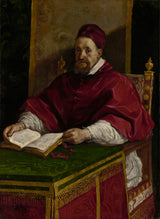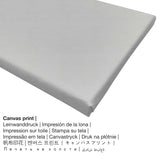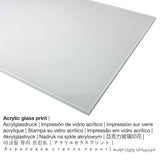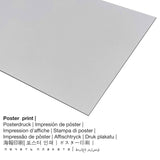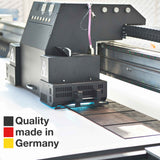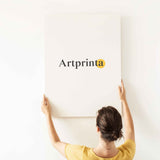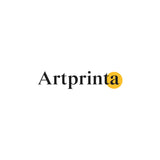General information from The J. Paul Getty Museum (© - Ụlọ ihe ngosi nka nke J. Paul Getty - Ụlọ ihe ngosi nka nke J. Paul Getty)
" Slanting light falls across the upper section of the painting, placing the left side of the sitter's face in shadow. He looks out of the picture, his eyes expressing weary concern. Shown in the act of reading a book at a small table, he seems more scholarly and retiring than powerfully vigorous.
In 1621 Guercino was called to Rome from Bologna to paint this portrait of Pope Gregory XV. Although Guercino rarely painted portraits, he used a composition that had become a standard for papal portraiture since the Renaissance. But Guercino placed less emphasis on the trappings of power than earlier papal portraits and more on his subject's character. This portrait shows a keen psychological understanding of his patron's state of mind, capturing the pope at the end of his life, worn out by the cares of office and failing health. "
Tebụl nka nka
| Aha nka nka: | "Pope Gregory XV" |
| Nhazi nka: | sere |
| Okwu nche anwụ: | nka ochie |
| Time: | 17th narị afọ |
| Afọ okike: | 1622 |
| Afọ nka: | karịa afọ 390 |
| Egosiputara na: | Ụlọ ihe ngosi nka nke J. Paul Getty |
| Ebe ngosi nka: | Los Angeles, California, Njikota Obodo Amerika |
| Weebụsaịtị nke ihe ngosi nka: | Ụlọ ihe ngosi nka nke J. Paul Getty |
| Licensedị ikike: | ngalaba ọha |
| Site n'aka: | Ụlọ ihe ngosi nka nke J. Paul Getty |
Nkọwa onye nka
| Ihe nkiri: | Guercino |
| okike nke onye nka: | nwoke |
| Obodo onye nka: | Italian |
| Ọrụ: | onye na-ese ihe |
| Obodo onye nka: | Italy |
| Otu nka: | nna ukwu ochie |
| styles: | Baroque |
| Oge ndu: | 75 afọ |
| A mụrụ: | 1591 |
| Ebe amụrụ onye: | Cento, Ịtali |
| Afọ ọnwụ: | 1666 |
| Nwụrụ na (ebe): | Bologna, Italytali |
Nkọwa ngwaahịa ahaziri ahazi
| Bipụta ngwaahịa: | ọmarịcha nka |
| Usoro mmeghari: | mmeputakwa n'ụdị dijitalụ |
| Produzọ mmepụta: | Mbipụta UV ozugbo |
| Ihe ngosi: | emere na Germany |
| Stockdị ngwaahịa: | mmepụta ihe na-achọ |
| Eji ngwaahịa emebere: | nka mgbidi, mgbidi gallery |
| Nhazi nke ihe nka: | nhazi ihe osise |
| Njikwa oyiyi: | 1: 1.4 - ( Ogologo: obosara) |
| Akụkụ onyonyo pụtara: | ogologo bụ 29% mkpụmkpụ karịa obosara |
| Ụdị ngwaahịa dị iche iche: | Mpempe akwụkwọ mmado (akwụkwọ kwaaji), mbipụta kanvas, mbipụta ọla (aluminium dibond), mbipụta iko acrylic (nwere ezigbo mkpuchi iko) |
| Nhọrọ nha nke akwa akwa n'elu etiti ihe na-agbatị (mbipụta kwaaji): | 50x70cm - 20x28", 100x140cm - 39x55" |
| Mbipụta iko acrylic (nwere ezigbo mkpuchi iko) nhọrọ nha: | 50x70cm - 20x28", 100x140cm - 39x55" |
| Nhọrọ nke mbipụta akwụkwọ mmado (akwụkwọ kwaaji): | 50x70cm - 20x28" |
| Nhọrọ nha mbipụta aluminium dibond: | 50x70cm - 20x28", 100x140cm - 39x55" |
| Nhazi mmeputa nka nka: | na-enweghị etiti |
Họrọ ngwa ngwaahịa gị
N'ime menu ndọpụta ngwaahịa ị nwere ike họrọ nha na akụrụngwa ọkacha mmasị gị. Ka ị kwekọọ n'ihe ị chọrọ nke ọma, ị nwere ike họrọ n'ime nhọrọ nhazi ngwaahịa ndị a:
- Kwaaji: A canvas direct print is a printed canvas mounted on a wooden stretcher. In addition to that, a canvas generates a cosy, enjoyable appearance. How can I hang a canvas print on the wall? A canvas print has the advantage of being low in weight, meaning that it is quite simple to hang up your Canvas print without the help of any wall-mounts. Therefore, a canvas print is suitable for all types of walls.
- Aluminom ihe eji eme ihe: An Aluminium Dibond print is a print material with an impressive depth - for a modern impression and a non-reflective surface. A direct Direct Print on Aluminum Dibond is your perfect start to fine replicas manufactured with aluminum. The bright & white parts of the work of art shine with a silk gloss, however without glow. Colors are bright and vivid in the highest definition, fine details appear very clear, and you can perceive the matte appearance of the art print surface.
- Mbipụta akwụkwọ mmado (ihe kwaaji): A poster print is a printed canvas paper with a granular surface finish, which reminds the original masterpiece. It is optimally designed for framing your fine art print with a personal frame. Please note, that depending on the size of the poster print we add a white margin of approximately 2-6 cm around the artwork, which facilitates the framing with your custom frame.
- Glass acrylic e biri ebi (nwere ezigbo mkpuchi iko): An acrylic glass print, often referenced as a plexiglass print, changes your favorite original work of art into beautiful décor and makes a distinct alternative option to canvas or aluminium dibond art prints. The acrylic glass protects your chosen art replica against light and heat for many more years to come.
Onyinye ngwaahịa ebipụta
"Pope Gregory XV" is a piece of art made by Guercino. Today, the piece of art belongs to the Ụlọ ihe ngosi nka nke J. Paul Getty art collection in Los Angeles, California, United States of America. With courtesy of Ụlọ ihe ngosi nka nke J. Paul Getty (ọha na eze).: . Ọzọkwa, alignment bụ Eserese na nwere ihe oyiyi ruru nke 1: 1.4, nke pụtara na ogologo bụ 29% mkpụmkpụ karịa obosara. Guercino was a painter, whose art style was primarily Baroque. The Italian painter lived for 75 years - born in the year 1591 in Cento, Italy and passed away in 1666.
Ederede iwu dị mkpa: We try to depict the products as closely as possible and to display them visually. Nonetheless, the tone of the printed materials, as well as the imprint may differ to a certain extent from the representation on your device's monitor. Depending on your settings of your screen and the nature of the surface, color pigments might not be printed as realisitcally as the digital version. In view of the fact that all our fine art prints are printed and processed manually, there may also be minor discrepancies in the motif's exact position and the size.
Ederede a bụ ikike ọgụgụ isi ma chekwaa ya site na nwebisiinka © | Artprinta (www.artprinta.com)

